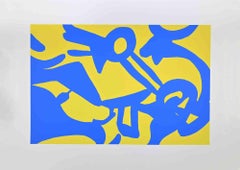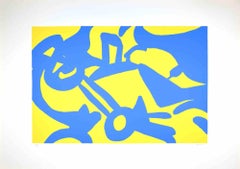Carla Accardi for sale on 1stDibs
Already an artist, and among the most representative of the Italian Postwar period, she leaves Florence and arrives in Rome as the only woman of the group Forma 1. She defines herself as a white fly who has managed to follow her vocation “because someone believed in me and that was my father”.
In Rome she meets Pietro Dorazio, Mino Guerrini, Achille Perilli and the younger Giulio Turcato. Occasionally, Severini went to Pietro Consagra’s studio (at that time he is a guest of Renato Guttuso in via Margutta 58) who appreciated the group’s works and defined Accardi’s works as full of verve.
In 1947 the artist creates her first abstract painting, Scomposizioni (Decompositions) - a general theme for all the artists part of the group - in the Accardi’s artwork there are intersections of triangles.
In the fifties there is her exhibition in Paris and Italy, where she meets the Turin gallery owner Luciano Pistoi, and in the seventies we see her political adhesion to feminism with her friend Carla Lonzi.
Her art was born from the idea that figuration is a transmission of spirituality, to which she arrives with a personal journey marked by meetings with friends such as Consagra, Burri, Fontana. Among the biggest artists, at various times, she has loved Kandinskij or Klee, Mondrian or Matisse.
In the artistic panorama of dualities, between figuration and abstraction, Carla Accardi chooses the Sign. Her work is based on the interaction between sign, surface, light, colour and transparency.
The importance of her sign begins around 1952, when she isolates herself believing that she can no longer do anything in painting, and she starts to draw directly on the ground. She makes some signs. First, she uses white on black, then she starts to draw shapes one on the top of the other - this produces strong differentiated signs. On Accardi’s opinion, the sign is a vent of subconscious and artistic expression, and language too.
A sign exists in relation to others, since it forms a structure with them. Its purpose is to represent the vital impulse that is in the world.
In 1965 it takes place a real revolution in Carla Accardi’s artistic activity, when she starts using different materials. She gives up the physical setting of the painting by realizing her signs on sicofoil supports (transparent and shiny material used in the industrial field) with transparent paints.
The idea of using sicofoil borns out of an interest in transparency - she wants to make her surroundings transparent and, therefore, she researches some colours that can adhere to, without detaching. She searches how to paint with them too.
The process she uses is: to prepare sheets of paper where to draw and to pay attention to the combination and emanation of the light, that derives from the colours.
The return to the rough canvas, as an inspiration of anti-painting, a desire for contradiction, this marks her last phase of artistic production.
Finding the Right Abstract-prints-works-on-paper for You
Explore a vast range of abstract prints on 1stDibs to find a piece to enhance your existing collection or transform a space.
Unlike figurative paintings and other figurative art, which focuses on realism and representational perspectives, abstract art concentrates on visual interpretation. An artist may use a single color or simple geometric forms to create a world of depth. Printmaking has a rich history of abstraction. Through materials like stone, metal, wood and wax, an image can be transferred from one surface to another.
During the 19th century, iconic artists, including Edvard Munch, Paul Cézanne, Georgiana Houghton and others, began exploring works based on shapes and colors. This was a departure from the academic conventions of European painting and would influence the rise of 20th-century abstraction and its pioneers, like Pablo Picasso and Piet Mondrian.
Some leaders of European abstraction, including Franz Kline, were influenced by the gestural shapes of East Asian calligraphy. Calligraphy interprets poetry, songs, symbols or other means of storytelling into art, from works on paper in Japan to elements of Islamic architecture.
Bold, daring and expressive, abstract art is constantly evolving and dazzling viewers. And entire genres have blossomed from it, such as Color Field painting and Minimalism.
The collection of abstract art prints on 1stDibs includes etchings, lithographs, screen-prints and other works, and you can find prints by artists such as Joan Miró, Alexander Calder and more.

